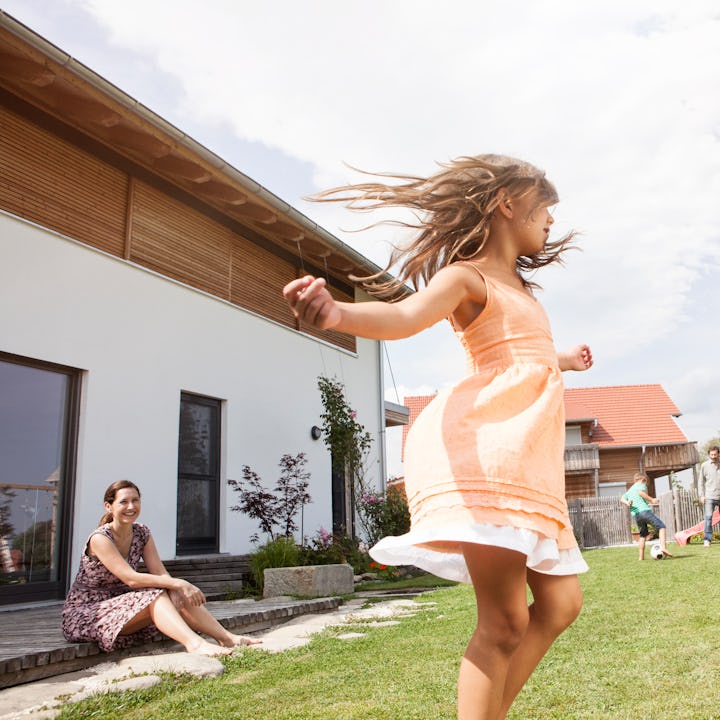"Sittervising" Is TikTok's New Parenting Trend, & Moms Are High-Key Here For It
They’re pushing past the mom guilt and leaning in — or sitting down, as it were.

Mom guilt is nothing new. It’s an inescapable virus fueled by Instagram photos, Pinterest activities, and that damn Jones family with whom we must keep up. Modern moms feel pressured to work, handle household chores, and then somehow find the energy to perform a dog-and-pony show anytime their kids say, “I’m bored.”
How can a mom deal? Welcome to sittervising.
What is sittervising?
Sittervising is supervising kids from a seated position, like a lounge chair, park bench, or any other comfortable location. Parenting expert Susie Allison coined the term to show parents safe ways to help kids play independently while enjoying a little self-care.
This win-win parenting trick benefits moms and kids alike.
“We can take a step back and still supervise them, still keep them safe,” says Allison. “We can do that and grow their autonomy, grow their risk management, grow their self-confidence, and all the other juicy, delicious parts of early childhood.”
While sittervising may seem simple, the concept of letting kids play alone has been lost on the current generation of hovering parents. We judge our parenting by how much we play with our kids, but that leaves no space for kids to develop their own skills. Sittervising gives children a chance to take control and make decisions.
How can you start sittervising?
Sittervising starts with giving yourself permission, says Allison. “We have permission to sit while our children are playing ... The goal is to allow the child to naturally grow and develop while also honoring the parent as a person.”
You can begin when your child is a baby. Watch and appreciate how they investigate a mirror, enjoy the texture of a toy, or snuggle with a lovey. This starts your family’s journey towards independent play.
If your child is a toddler or school-aged, you can still teach them independent play skills. Here are the steps that Allison recommends.
Safety First
Remember the “supervise” part of sittervising! Create safe play spaces and monitor your child closely.
Make a Playtime Routine
Schedule a special time for play, and stay consistent every day. You might plan playtime after breakfast, before a nap, or close to dinner time. The actual time is less important than the ritual. Each day, tell your child that this is their special playtime.
Start Small
Like any skill, playing independently takes practice. In the beginning, strive for 5 minutes. Tell your child, “I need to sweep the floor. Your job is to play with your blocks for 5 minutes.” Then, keep your promise and check in after 5 minutes.
Use a Visual Timer
“Five minutes” doesn't mean much to a toddler. To help them understand, use a visual timer or a sand timer. Keep the mood light by letting your child set the timer. They will enjoy the novelty and responsibility.
Don’t Butt In!
Let sleeping dogs lie, and let playing toddlers play! If your child makes the decision to play alone, do not interrupt them. It’s tempting to complement their beautiful artwork, fix their wobbling tower, or ask a question. Resist the urge. Give them a chance to develop skills on their own, and you can join them later.
Stay Strong
Your child may ask you to join in before independent playtime is over. It’s hard to refuse their big begging eyes and constant requests, but you’ll be glad you did in the end. Eventually, your child will understand the routine and know that you’ll be available soon.
Ditch Your Mom Guilt
Sittervising challenges us to reframe our perspective on being a good parent. In addition to playing with our children, there are other ways to connect, like going for walks, cooking, snuggling, or reading. Find exciting new ways to bond with your child. Your child will discover that they can enjoy time with you beyond play.
Does sittervising work?
Real moms are excited about sittervising. On social media, parents are sharing sittervising moments, like relaxing outside while the kids splash at a water table, dig in a sandbox, or run on the playground. Scrolling through the #sittervising Instagram and TikTok posts, you can see smiling, laughing kids — having a blast even though mom is sitting down.
As with any parenting strategy, haters gonna hate, and trolls might call sittervising “lazy parenting.” In reality, it takes strength to step back and give kids their own spotlight.
“I was always playing with my toddler, determining his activities and the direction of his play,” says Kusi Camperlino, a mom of two children and an elementary school teacher. “I realized he needed to learn to play independently — and sometimes I needed a break.”
Camperlino discovered sittervising on social media and decided to give it a try. Her son has learned to play independently throughout the day for 5-minute stretches.
Whitney Good, a mom of two toddlers, has watched her kids thrive through sittervising. “It helps with their creativity, problem-solving skills, and even confidence,” says Good. “And a few minutes to sit on the sidelines and relax? You bet I’ll take advantage of that!
This article was originally published on